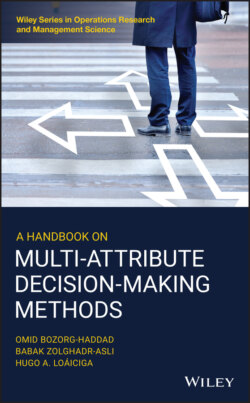Читать книгу A Handbook on Multi-Attribute Decision-Making Methods - Omid Bozorg-Haddad - Страница 23
2.3 The Weighted Product Method
ОглавлениеThe WPM employs multiplication for synthesizing the attributes' performance values, each of which is raised to the power of the corresponding attributes' weights. In essence, compared to the WSM, the WPM penalizes alternatives with poor attribute preference values more heavily (Triantaphyllou and Mann 1989; Chang and Yeh 2001; San Cristóbal 2012). WPM has been successfully implemented in bidding strategies (Wang et al. 2010), business strategic planning (Chang and Yeh 2001), energy resources management (Pohekar and Ramachandran 2004), environmental evaluations (Zhou et al. 2006), technological instrument selection (Savitha and Chandrasekar 2011), supply chain management (Chou et al. 2008), and waste management (Cheng et al. 2003).
The WPM follows the same basic steps applied in the WSM. The following is a stepwise procedure to implement the WPM in an MADM problem:
Step 1: Defining the decision‐making problem
Step 2: Normalizing the elements of the decision‐matrix
Step 3: Aggregating the preference of alternatives
Equation (2.10) synthesizes the alternatives' performance values (Chang and Yeh 2001):
(2.10)
This method is also considered as a compensatory MADM method where the assumption of criteria independency is made (Saaty and Ergu 2015).
